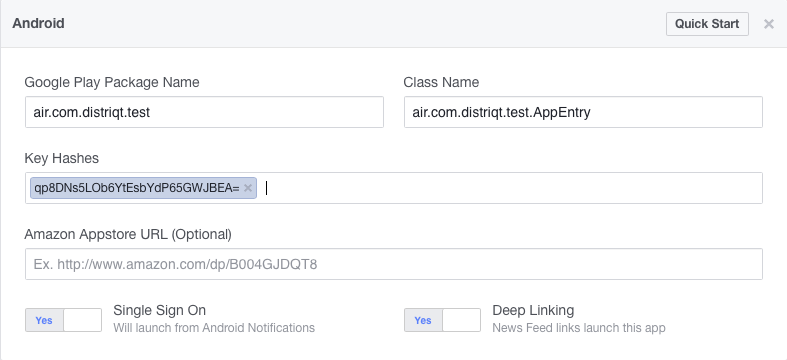Facebook Android App
This is the legacy extension documentation. Find the new documentation here
Setup: Facebook Android App
For Android, you'll need to set some properties about your app here. Here's an example of the settings we're using:

| Google Play Package Name | This is the ID of your AIR application as set in your application descriptor. This is generally a reverse DNS style name, such as air.com.distriqt.test. Be sure to note the air prefix |
| Class Name | This is the name of the base Android AIR class which launches your app. It will be the same as your app ID, but with the prefix air and the suffix .AppEntry. For example, our app would use air.com.distriqt.test.AppEntry |
| Single Sign On | Turn this to ON. This is required for users to be able to log in through your application. |
| Deep Linking | Turn this to ON. This is not required, but will be needed if you want to be able to link back to your app from Facebook links. |
| Key Hashes | See the following section for instructions on how to generate your key hashes for Android. |
Android: Key Hashes
Android Facebook apps require that you enter one or more key hashes from the certificates used when building and sigining your APK application. There are generally different signatures used with development and release versions, so you will likely need to add two of these values.
The key hash is a 28 digit string ending with an =:
qp8DNs5LOb6YtEsbYdP65GWJBEA=
Facebook has documentation on this process here, however we outline the key concepts below.
The first step is to locate the certificate file (p12) you are using to sign your
application.
Once you've located the correct P12 certificate file(s), run the following command,
replacing CERTIFICATE.p12 with your certificate file path.
keytool -export -alias 1 -storetype pkcs12 -keystore CERTIFICATE.p12 | openssl sha1 -binary | openssl base64
The output of this command is the value you need to paste into the Facebook Android settings key hash fields.
The alias parameter is usually 1, however this may not always be the case. In order to verify that, you can run the following command, again replacing CERTIFICATE.p12:
keytool -v -list -keystore CERTIFICATE.p12 -storetype pkcs12
Which will output some information about the certificate, including a value called Alias name. This is the alias parameter that's required.
Flash Builder
If you are running debug builds from Flash Builder, it uses a different P12 file than you might expect. You'll need to get the key hash from the following certificate for debug builds.
On OSX:
/Applications/Adobe Flash Builder 4.7/eclipse/plugins/com.adobe.flexide.multiplatform.android_4.7.0.349722/resources/debug-certificate-android.p12
On Windows it will be similar to:
C:\Program Files\eclipse\plugins\com.adobe.flexide.multiplatform.android_4.7.0.349722\resources\debug-certificate-android.p12